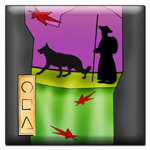On The Way: The Daily Zen Journal
Delusion and Zazen – Part 2
Kosho Uchiyama (1912-1999)

In the zazen posture we are able to calm down, and our mental excitability diminishes. It is by nature a posture in which it is impossible to think continuously about the same thing, and the fictions we set up in our heads dissolve.
Therefore, when doing zazen we just sit, letting go of everything that comes up. All that has been learned is given back to learning, all that is memorized is given back to memory, all that has been thought is given back to thought. To let go of everything — that is the posture of zazen.
When we are doing zazen, does this mean that thoughts no longer arise, and that our heads become empty? No, of course not. As long as we are alive it is only natural that various thoughts arise, even when we are doing zazen. What is crucial is to let them come and go of themselves without pursuing them or driving them out.
For example, a thought comes up: if we follow it, then we are thinking and no longer sitting zazen, even though we are in the zazen posture. In zazen, it is important not to chase after thoughts.
On the other hand, when a thought comes up, should we try to wipe it out? If we do, then we end up thinking that we have to try to wipe out that thought. Rather, when doing zazen, we commit everything to the posture, without chasing after or chasing out thoughts.
In the same way, when we take the zazen posture, if we doze off we are napping and not doing zazen. Just as doing zazen is not thinking while sitting, neither is it napping or dozing off while sitting. Therefore, full of vigor, we just aim at the correct zazen posture with our flesh and bones. Just practicing this is doing zazen.

Moreover, it is of utmost importance here not to indulge in self-observation. Self-observation, or observing the effect of our zazen, such as being calmer or more agitated, not only misses the mark, but the moment we do so, we impair zazen and go off the track.
Zazen has nothing to do with thinking about results. It is essential just to aim at the posture of zazen without trying to observe its effects.
You may feel that being unable to observe the effect of your zazen will lead to tremendous dissatisfaction. It is only natural to feel this, for zazen throws out our petty thoughts that seek satisfaction and manifests life purely as life. The feeling that something is lacking is no more than our petty thoughts of being unfulfilled.

Sawaki Roshi used to say,
“There is no reason to expect the reality of immeasurable and unbounded life to satisfy your puny little thoughts.”
Only when we let go of all such ideas will our life find peace in the purity of full life, because it is just these dissatisfied thoughts and our being tangled in ideas of existence or nonexistence that throw our lives into anxiety and drag us into suffering, fighting, hopelessness, and despair. It is through the posture of letting go of these thoughts that we are able to discover the absolute peace of life.

Nevertheless, this peace is not the cessation or extinction of life; it is not seclusion or escapism. Far from it. Living in peace is the unfettered realization of life as life and is not at all off in the clouds.
Rather, all reality, undisturbed by thought, is reflected as it interdependently appears and disappears. Genuine peace is like a clear mirror that simply reflects all images as they are, without anything sticking to it.
Zazen is itself practicing the Middle Way with our own bodies. The Middle Way is itself true life. This can be seen in our daily lives as well. For example, when we are driving a car, if we are tense, or absorbed in our thoughts, our life becomes totally confused and we cannot manifest it as it is. Our driving becomes highly dangerous.
At the same time, it is hazardous to drive when sleepy or drunk, which also blinds us. We can drive safely only when we are relaxed and at the same time wide awake.

Zazen is the posture through which our life force manifests itself most naturally and purely.
Kosho Uchiyama (1912-1999)
Excerpted from Opening the Hand of Thought – Foundations of Buddhist Practice Kosho Uchiyama, 2004





Simplicity and clarity. The above guidelines are touchstones that help us to steer through practice. To take it all a step further is finding a way to return to zazen while walking, lying down, and standing.
Zazen is our foundation, and living it as a part of daily life is our next step. To anchor our lives in practice is like the aging of a fine wine. It does take time. Here is where we take the reins of creativity into our own hands to find our way to return.
The posture of zazen is not something that is limited to meditation. Posture itself can be a reminder for us. To become aware of leaning back, leaning to the side on a chair arm, or leaning forward can spark awareness and is an indicator of our inner state. However, there are many ways to enter the present. The key is to find one that suits you rather than following someone else.
We all want a pathway to mindfulness in daily life. The most powerful one will come from your own life experience and will present itself when the time is right. It is not something we can force which could become mechanical.
Imagine a line of dominoes stacked next to each other. When one touches the first one, the entire line falls. What if we could take a domino or two out of that line of action which would allow us to pause for a moment? The doing could be replaced with Being for a while.
What will be your next step here? No one else can give this to you.
Sitting in the lap of the Universe,
Elana, Scribe for Daily Zen